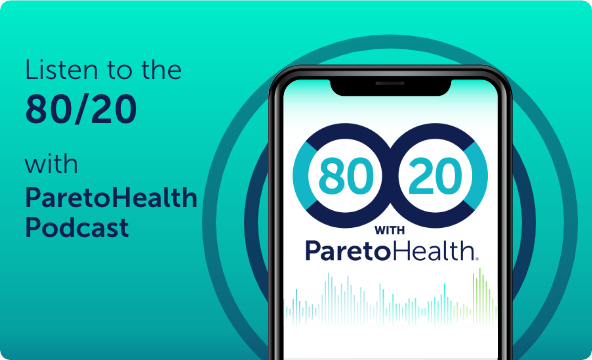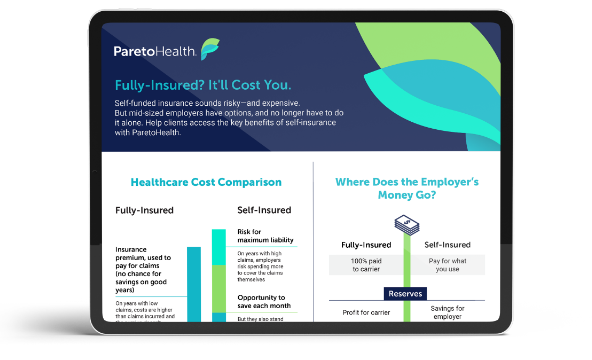5 Ways ParetoHealth Captives Manage Volatility
Most people think of volatility as a bad thing. Prices go up, the stock market goes down, and your pockets feel distinctly lighter at the end of the day than they did at the beginning.
But what if I told you this was only one of the aspects of volatility?
...In other words, what if there was an advantage to volatile prices that you could tap into, if you only had the proper structure to do it in?
Well, you’re in luck. That’s exactly what I’m about to tell you.
You see, your costs can swing both ways – up or down.
The goal for any risk-management solution is to give you as much positive exposure as possible, while sheltering you from the downsides. What you want to do is get as much as you can from good years, while stopping the bad years from taking you out of the game completely.
Let’s look at an example to make it clearer.
Big insurance companies like it when people use old-fashioned insurance products – when you pay large, fixed costs every year. They call it fully insured, but that’s just a marketing term.
If you pay $1,000,000 dollars to insure your employees, but their costs come to only $400,000, what happens?
Well, you're rewarded with next year’s renewal quote: $1,100,000. “They” pat you on the back and tell you this is a great deal for you.
In other words, you don’t get the benefits of positive volatility.
On the other hand, if your employee claims are $1,600,000, then your carrier makes a serious face and tells you that with claims like those, you ought to be grateful that your renewal is “only” $1,800,000...
...Even if the vast majority of these are one-time claims. You know – not likely to arise again.
With your new-found knowledge of positive and negative volatility, you should see what’s going on here:
You aren’t exposed to positive volatility, but you’ll pay dearly for negative volatility. The system is literally rigged against you. There’s no winning.
Now, let’s say you are self-insured. Here’s the situation:
In a good year, you pay only for the $400,000 of claims actually incurred. You gained some positive exposure to volatility. In the bad year, you pay the full $1,600,000, because you also have full exposure to negative volatility.
If you have the cash on hand to absorb the costs of a bad claims year, then you have a shot at reaping the benefits of this type of insurance. But it’s not as simple as that.
We’ve talked on The Contrarian before about the biggest risks for self-insured employers in 2022. These have one big thing in common:
The claims are mostly low-incidence and high-cost. This means that most of your years will be good – the problem is that the bad years can be so costly that they take you out of the game.
This brings us to the five ways that our captives shield you from negative volatility while also allowing you the benefits of positive volatility:
1. Risk-sharing
When you join a benefits captive, you share risk with the other members. This means that you accept a small portion of their risk and they accept a small portion of yours.
This means that in a good claims year, you might pay a small amount more than you would otherwise – continuing our example from above, this might be around $410,000. However, it also means that in a bad year, you’ll only pay $900,000 – you aren’t socked with the extra $700,000 that you saw above.
Better than that, your renewals won’t be ruinously expensive.
After good claims years, they can even be negative. As in, you pay less for next year.
Wild, right?
Another important aspect of how this can work is the following:
2. Vetting of new members
We don’t just let anyone become a captive member.
It requires a process of vetting and education. Let’s break that down:
The vetting process makes sure that an employer is financially viable. You don’t want to share risks with someone whose house isn’t in order, and chasing short-term gains risks weakening the captives.
Second, we need people who understand the nature of our solutions. Unlike old-fashioned insurance products, these require engagement and initiative. The last thing we want is to let people in before they’re ready.
By the way, this is a perfect time to shout out to our benefits Consultants. Without their expert guidance, that education effort would be much more difficult.
So that means we’re exclusive – not by industry or the flashiness of your sports car, but instead by whether you share the proper mindset. It’s part of our responsibility to ensure that our community of like-minded employers stays that way.
Our next way that the benefits captive manages volatility is related to this one:
3. Cost Management Efforts
During the vetting process, we make sure that every employer is serious about implementing cost management efforts (stay tuned for more articles on our approach regarding this: it’s too big a topic to cover fully here).
This means one thing: every Member gets the benefits of all of these cost-management efforts.
Want to hear a secret?
When you use other insurance products, you’re also sharing risks...
...But it’s with an anonymous mass of strangers. You don’t know if they’re pursuing the best care at the lowest cost, whether they have a wellness program, if they pay for gym memberships for their employees...
You don’t know anything about them. Knowing the people that you share risk with should be the rule, not the exception. But it almost never is.
This transparency is a key reason that our benefits captives are the largest in the country. People like to know that their risk-sharing is in good hands.
Our growth has led us to another key part of our strategy:
4. Size and buying power
Our captives manage almost three billion dollars in healthcare spending.
Let that sink in.
To put it in context, in terms of pure healthcare spend, these captives are bigger than a couple of well-known companies:
- • Meta (Facebook)
- • Apple
- • Exxon Mobil
...Well, you get the idea.
And with that size, we can negotiate terms from our stop-loss providers that are among the best anywhere.
That’s a major part of our mission: delivering enterprise-level healthcare solutions to small and medium businesses. When we act together, we can do things that were impossible when we all acted separately.
Look, if you want to take on the big insurance companies, you need to be big as well. And if you’re not big, you need to belong to a big club.
By acting together, you can work for yourself much better. You can understand what you’re doing, share ideas with everyone else, and learn from everyone’s mistakes and victories.
That brings us to my last point:
5. Transparency
If you have access to your own healthcare data, you can make the right interventions.
Think about it:
If you know that a lot of your claims are coming from people with end-stage renal disease or diabetes, you can tailor your wellness program to answer those needs specifically.
If you don’t know what’s going on, then you’re forced to fly blind and address problems that your people may not even have.
By making things transparent, by introducing skin in the game, and by respecting local knowledge and expertise, we can take a long-term approach to healthcare.
Isn’t that the entire point of strategic leadership? I think so.
That’s something that you’re not going to get with the dinosaurs who are still pushing old-fashioned, one-size-fits-nobody policies. If you have no healthcare data, you can’t apply the Pareto Principle – focusing on the 20% of problems that are causing 80% of your expenses.
No, it’s not named after us. But people always ask.
Check out our resources if you’re ready to learn about captive insurance and what it can do for your healthcare spend.
And, as always, don’t forget to subscribe to future posts from The Contrarian using the form below.
There’s a Better Way to Do Employee Health Benefits
Join an upcoming webinar to learn how ParetoHealth turnkey employee health benefits solutions deliver the scale and resources mid-sized businesses need to self-insure with total confidence. By combining a captive model with comprehensive medical and pharmacy cost containment strategies, our members realize significant cost savings with multi-year protection.
Learn why 97% of members who join ParetoHealth, stay with ParetoHealth.

 By Andrew Clayton
By Andrew Clayton  June 14, 2022
June 14, 2022 





